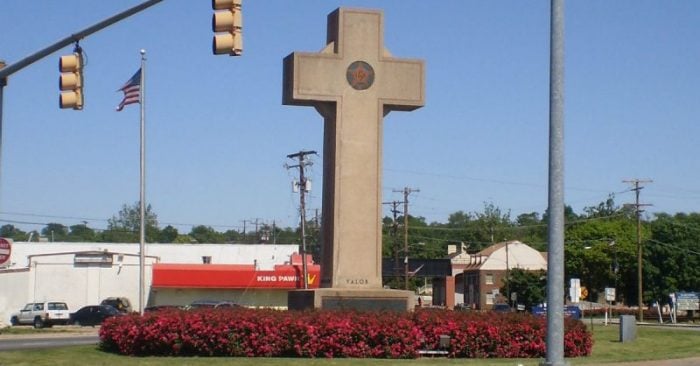
Atheists are not happy about this.
In a 7 to 2 vote, the Supreme Court ruled that a 40-foot cross built as a tribute to the military dead may remain on public land in Bladensburg Maryland.
The Supreme Court ruled that the cross does not violate the separation between church and state so it can remain standing.
They rejected arguments that it was an unconstitutional endorsement of religion.
History and tradition must be taken into account when judging modern objections to monuments on public land, Justice Samuel A. Alito Jr. wrote. Alito wrote the main opinion on the ruling.
“The cross is undoubtedly a Christian symbol, but that fact should not blind us to everything else that the Bladensburg Cross has come to represent,” Alito said.
“For some, that monument is a symbolic resting place for ancestors who never returned home. For others, it is a place for the community to gather and honor all veterans and their sacrifices for our Nation. For others still, it is a historical landmark.”
“For many of these people, destroying or defacing the Cross that has stood undisturbed for nearly a century would not be neutral and would not further the ideals of respect and tolerance embodied in the First Amendment,” Alito said.
Justices that decided that the cross would remain included Chief Justice John G. Roberts Jr. and Justices Clarence Thomas, Stephen G. Breyer, Elena Kagan, Neil M. Gorsuch and Brett M. Kavanaugh.
Justice Ruth Bader Ginsburg dissented from the 7-2 ruling in the case along with Justice Sonia Sotomayor.
“Just as a Star of David is not suitable to honor Christians who died serving their country, so a cross is not suitable to honor those of other faiths who died defending their nation,” Ginsburg wrote in her dissent, joined by Justice Sonia Sotomayor. “Soldiers of all faiths ‘are united by their love of country, but they are not united by the cross.'”
An atheist group previously tried to remove the cross-shaped World War I monument in Maryland ahead of a SCOTUS ruling. The public memorial honors 49 men from Prince George’s County who died serving our country and protecting our freedoms.
The attempt received backlash from service members who view the attempt as an attack on American values and those who died to defend those values.
The Peace Cross was constructed between 1919 and 1925 making it nearly 100 years old. According to the Daily Signal, the cross faces potential demolition pending a ruling from the Supreme Court.
The controversy all started in 2014 when the American Humanist Association filed a lawsuit to have the public memorial removed. According to the group, taxpayer-funded government maintenance of the cross-shaped monument violates the First Amendment by promoting Christianity.
At the time, a lower court ruled against the American Humanist Association, siding with the Park and Planning Commission and the American Legion, America’s largest veteran’s service association, which originally funded the monument. However, in 2017, a three-judge panel of the 4th U.S. Circuit Court of Appeals in a 2-1 decision that the monument was unconstitutional.
Yet, defendants uphold that the monument was erected for the purpose of honoring the brave men who have made the ultimate sacrifice. They believe that the message of the memorial is patriotic first and foremost.
Veterans who have weighed in were not happy.
“Americans of all faith backgrounds should be outraged,” Jake Hill, a lance corporal in the Marine Corps told The Daily Signal.
“Where will this end? Will they begin chiseling the crosses and stars of David off gravestones in Arlington [National Cemetery] next?” he asked.
Mike Moore, a 73-year-old Army veteran from Lanham, Maryland believed that the Atheist group was reaching with their claims.
“I think it’s a reach to say that this is a First Amendment violation of the separation of church and state,” Moore said. “There are lots of things in the form of a cross which are not necessarily expressions of religion…There’s all kinds of servicemen’s medals in the form of the cross that have no religious connotation to them.”


